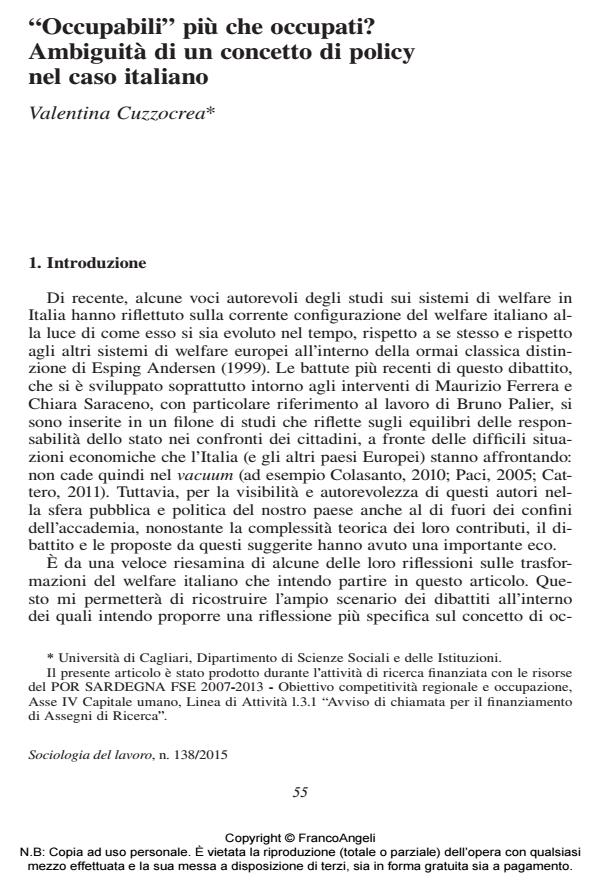"Occupabili" più che occupati? Ambiguità di un concetto di policy nel caso italiano
Titolo Rivista SOCIOLOGIA DEL LAVORO
Autori/Curatori Valentina Cuzzocrea
Anno di pubblicazione 2015 Fascicolo 2015/138
Lingua Italiano Numero pagine 14 P. 55-68 Dimensione file 109 KB
DOI 10.3280/SL2015-138004
Il DOI è il codice a barre della proprietà intellettuale: per saperne di più
clicca qui
Qui sotto puoi vedere in anteprima la prima pagina di questo articolo.
Se questo articolo ti interessa, lo puoi acquistare (e scaricare in formato pdf) seguendo le facili indicazioni per acquistare il download credit. Acquista Download Credits per scaricare questo Articolo in formato PDF

FrancoAngeli è membro della Publishers International Linking Association, Inc (PILA)associazione indipendente e non profit per facilitare (attraverso i servizi tecnologici implementati da CrossRef.org) l’accesso degli studiosi ai contenuti digitali nelle pubblicazioni professionali e scientifiche
Secondo il principio di occupabilità, promosso dall’Unione Europea e da vari governi nazionali tra cui quello italiano, il lavoratore o aspirante lavoratore è ritenuto responsabile della propria posizione nel mercato del lavoro. Il focus sul miglioramento della capacità di ognuno di collocarsi nel mercato del lavoro, e di mantenere una posizione lavorativa, dà luogo ad un vero e proprio discorso sull’occupabilità, che è diventato dominante nelle politiche del lavoro e di formazione. Nonostante la sua diffusione, il concetto di occupabilità è rimasto principalmente un concetto di policy ed è stato raramente oggetto di riflessione teorica. Questo contributo riflette sulle definizioni del concetto, ponendole in relazione al contesto italiano e a recenti dibattiti su come si stia trasformando il welfare italiano, e mira a metterne in evidenza alcune ambiguità, in particolare la sua valenza ideologica, concludendo che ad una maggiore occupabilità possa non seguire necessariamente una maggiore occupazione.
Parole chiave:Occupabilità, sistema di welfare, Italia, discorsi, ideologia neoliberista
- Stasis in Moltmann e Schmitt (Stasis in Moltmann and Schmitt) P. G. Monateri, in SSRN Electronic Journal /2013
DOI: 10.2139/ssrn.2373071 - Youth and Unconventional Political Engagement Ilaria Pitti, pp.63 (ISBN:978-3-319-72136-1)
- Diversity and Inclusion in Italy Fabio Gaspani, Sara Recchi, Anna Rio, pp.637 (ISBN:978-3-031-81937-7)
- Generations Z in Europe Sebastiano Benasso, Valentina Cuzzocrea, pp.149 (ISBN:978-1-78973-492-8)
Valentina Cuzzocrea, "Occupabili" più che occupati? Ambiguità di un concetto di policy nel caso italiano in "SOCIOLOGIA DEL LAVORO " 138/2015, pp 55-68, DOI: 10.3280/SL2015-138004